-

新人教版高中英语选修2Unit 5 Reading for writing教学设计
你校英语报计划出版一期急救常识专刊,现面向全校学生公开征集稿件,你有意参加。请你根据下面提示内容,用英语写一篇短文,介绍在车祸现场对伤者进行急救的方法和步骤。1.确保现场的安全;2.询问伤者,确保其呼吸正常;3.检查伤口,如流血则应采取止血措施;4.如需急救,确保其处于康复位置。注意:1.词数80左右;2.可以适当增加细节,以使行文连贯。参考词汇:康复位置 recovery positionAs we all know, having a knowledge of first aid can make a great difference in our daily life. If a traffic accident happens and someone is injured, the following steps can be used to treat the injured.In the first place, we should make sure that the accident scene is safe so that we won’t get hurt. We should ask the injured person if he is OK, and see if he is breathing. What’s more, we should check for cuts and wounds. If he is bleeding badly, it is vital that we should try to stop the bleeding by applying pressure to the injury. This is because if a person loses too much blood, he may die. If necessary, take the injured person to the hospital as soon as possible.Do remember: when giving first aid, please be sure to place the person in a recovery position.

新人教版高中英语选修2Unit 3 Using langauge-Listening教学设计
1. How is Hunan cuisine somewhat different from Sichuan cuisine?The heat in Sichuan cuisine comes from chilies and Sichuan peppercorns. Human cuisine is often hotter and the heat comes from just chilies.2.What are the reasons why Hunan people like spicy food?Because they are a bold people. But many Chinese people think that hot food helps them overcome the effects of rainy or wet weather.3.Why do so many people love steamed fish head covered with chilies?People love it because the meat is quite tender and there are very few small bones.4.Why does Tingting recommend bridge tofu instead of dry pot duck with golden buns?Because bridge tofu has a lighter taste.5 .Why is red braised pork the most famous dish?Because Chairman Mao was from Hunan, and this was his favorite food.Step 5: Instruct students to make a short presentation to the class about your choice. Use the example and useful phrases below to help them.? In groups of three, discuss what types of restaurant you would like to take a foreign visitor to, and why. Then take turns role-playing taking your foreign guest to the restaurant you have chosen. One of you should act as the foreign guest, one as the Chinese host, and one as the waiter or waitress. You may start like this:? EXAMPLE? A: I really love spicy food, so what dish would you recommend?? B: I suggest Mapo tofu.? A: Really ? what's that?

新人教版高中英语选修2Unit 4 Learning about Language教学设计
This section guides students to pay attention to the typical context of vocabulary use, helps students accumulate vocabulary around the key vocabulary of this unit, and uses the learned words and word chunks in different contexts to deeply understand their meaning and usage, so as to achieve the purpose of review and consolidation.The teaching design activities aim to guide students to pay attention to the typical context in which the target vocabulary is used, as well as the common vocabulary used in collocation, so that students can complete the sentence with correct words. In terms of vocabulary learning strategies, this unit focuses on cultivating students' ability to pay attention to collocation of words and to use word blocks to express meaning.For vocabulary learning, it is not enough just to know the meaning of a single word, but the most important thing is to master the common collocations of words, namely word blocks.Teachers should timely guide students to summarize common vocabulary collocation, such as verb and noun collocation, verb and preposition collocation, preposition and noun collocation, and so on.1. Guide students to understand and consolidate the meaning and usage of the vocabulary in the context, 2. Guide the students to use the unit topic vocabulary in a richer context3. Let the students sort out and accumulate the accumulated vocabulary, establishes the semantic connection between the vocabulary,4. Enable students to understand and master the vocabulary more effectivelyGuiding the Ss to use unit topic words and the sentence patterns in a richer context.

新人教版高中英语选修2Unit 4 Reading for writing教学设计
假定你是英国的Jack,打算来中国旅行,请你给你的中国笔友李华写一封信,要点如下:1.你的旅行计划:北京→泰山→杭州;2.征求建议并询问他是否愿意充当你的导游。注意:1.词数80左右(开头和结尾已给出,不计入总词数);2.可以适当增加细节,以使行文连贯。参考词汇:故宫 the Forbidden City;泰山 Mount TaiDear Li Hua,I'm glad to tell you that 'm going to visit China.First,I am planning to visit Beijing,the capitalof China,where I am looking forward to enjoying the Great Wall,the Forbidden City and somebeautiful parks.Then I intend to go to visit Mount Tai in Shandong Province.I've heard that it is one ofthe most famous mountains in China and I can't wait to enjoy the amazing sunrise there.After that,I amalso going to Hangzhou.It is said that it is a beautiful modern city with breathtaking natural sights,among which the West Lake is a well- known tourist attraction.What do you think of my travel plan? Will you act as my guide? Hope to hear from you soon.

新人教版高中英语选修2Unit 5 Using langauge-Listening教学设计
The theme of this section is to learn how to make emergency calls. Students should learn how to make emergency calls not only in China, but also in foreign countries in English, so that they can be prepared for future situations outside the home.The emergency telephone number is a vital hotline, which should be the most clear, rapid and effective communication with the acute operator.This section helps students to understand the emergency calls in some countries and the precautions for making emergency calls. Through the study of this section, students can accumulate common expressions and sentence patterns in this context. 1.Help students accumulate emergency telephone numbers in different countries and learn more about first aid2.Guide the students to understand the contents and instructions of the telephone, grasp the characteristics of the emergency telephone and the requirements of the emergency telephone.3.Guide students to understand the first aid instructions of the operators.4.Enable Ss to make simulated emergency calls with their partners in the language they have learned1. Instruct students to grasp the key information and important details of the dialogue.2. Instruct students to conduct a similar talk on the relevant topic.Step1:Look and discuss:Match the pictures below to the medical emergencies, and then discuss the questions in groups.

新人教版高中英语选修3Unit 2 Healthy Lifestyle教案
Activity 4: Figuring out the structure and the writing purpose 本活动为实现课时目标2。 1.Read Paragraph 6 and think about its main idea and the writer’s writing purpose. Q1: If you were the author, how would you end your article? “For young people, there is plenty of time to change bad habits. However, there is no “magic pill” or delete button that will help you; you have to think about your bad habits and decide on some changes. You have the power to build a happy and healthy life full of good habits!” Q2: What is Paragraph 6 mainly about? (Possible answer: to appeal to young people including teenagers to change bad habits and live a happy and healthy life.) 2.Think about the writer’s writing purpose and share opinions. Q1: What is the writing purpose? Work in pairs and figure it out. (Possible answer: On the one hand, the passage is written to help teenagers change their bad habits and live a healthy lifestyle. On the other hand, it provides us with a scientific way to identify and analyse our problems objectively, thus strengthening our resolve to tackle the seemingly common yet tough problems in our lives.) 【设计意图】 步骤1旨在预测和验证文章最后一段主要内容,梳理完整的语篇结构,步骤2旨在思考和讨论作者的写作目的。教师也可根据学生课堂反应情况融入对语篇人称多次转换的思考。

新人教版高中英语选修4Unit 2 Iconic Attractions教案
帮助学生通过讨论与对主题的提升,反思自己的旅游方式,以便做出更优化的安排,在今后的旅程中有更多的收益。 Activity 2: Further discussion of the 6 elements above and supplement of more background knowledge 本活动为实现课时教学目标2。 1.Target Q: The writer’s clear target of traveling, meeting the people and experiencing the culture, is closely related to his major in social studies. Then what is social studies? Social studies is a part of a school or college curriculum concerned with the study of social relationships and the functioning of society and usually made up of courses in history, government, economics, civics, sociology, geography, and anthropology. (Dictionary by Merriam-Webster) Reflection: When you go out to travel, what targets do you usually have in mind? 2.Research Q: Suppose you are traveling to Hangzhou during the school holidays, how will you do research on the city? (surf the internet, read books or travel brochures, consult friends, ...) What information will you be interested to know? (location, iconic sites, local cuisines, interesting customs, shopping malls ...) 3.Abandonment To make the most of time, we have to learn to abandon so that we can accomplish our plan. What will you be interested in doing if you go to Hangzhou if you have a week’s time? What if you only have 2 days? 4~5. Venturing & Experiencing Q: What did he venture to do during the trip? What new experiences did he have? In Sydney: attend his first open-air barbecue, enjoy many different but yummy meals In Catherine: observe the life and customs of the aborigines appreciate their music & try the musical instruments: the didgeridoo
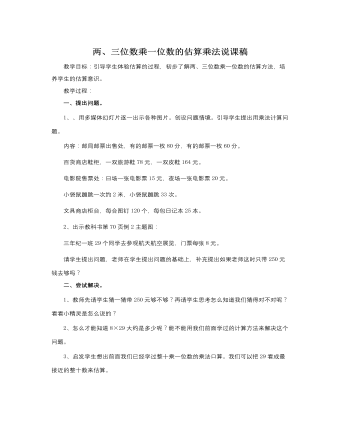
人教版新课标小学数学三年级上册两、三位数乘一位数的估算乘法说课稿
1、、用多媒体幻灯片逐一出示各种图片。创设问题情境。引导学生提出用乘法计算问题。内容:邮局邮票出售处,有的邮票一枚80分,有的邮票一枚60分。百货商店鞋柜,一双旅游鞋78元,一双皮鞋164元。电影院售票处:日场一张电影票15元,夜场一张电影票20元。小袋鼠蹦跳一次约2米,小袋鼠蹦跳33次。文具商店柜台,每合图钉120个,每包日记本25本。2、出示教科书第70页例2主题图:三年纪一班29个同学去参观航天航空展览,门票每张8元。请学生提出问题,老师在学生提出问题的基础上,补充提出如果老师这时只带250元钱去够吗?二、尝试解决。1、教师先请学生猜一猜带250元够不够?再请学生思考怎么知道我们猜得对不对呢?看看小精灵是怎么说的?2、怎么才能知道8×29大约是多少呢?能不能用我们前面学过的计算方法来解决这个问题。3、启发学生想出前面我们已经学过整十乘一位数的乘法口算。我们可以把29看成最接近的整十数来估算。

统编版三年级语文上第14课小狗学叫
《小狗学叫》这篇童话通过拟人的手法,叙述的是一只小狗学叫的故事。构思新颖,想象丰富,作者的情思寄寓在形象的描写中,耐人寻味。故事读起来看似有点荒诞无稽,但细品之后谁也不会去怀疑和谈论故事的真实性,而是深刻地思考品评故事所暗示的“小狗终于做成真正的狗,找回迷失的自我”的主题。作者曾经说过:“在每一件事物中都有一个故事,这些故事在桌子的木头中,在玻璃中,在玫瑰中……” 《小狗学叫》正是以现实生活为基础,在每一件事中挖掘故事,把现实世界的偶然现象和必然因素统一起来,把故事情节的曲折变化和人物性格的逻辑发展结合起来,通过这一高超的艺术辩证法,幽默地展示出现实社会中的某些现象,使人们在笑声中受到教育和启发。我们可用多媒体课件等形象的教学手段,拉近学生与文本之间的距离。 1.会认“讨、厌”等11个生字,读准“吗、担”等5个多音字。2.能预测故事的结局,并将自己的预测与原文进行比较,体会预测的多样性,培养学生听故事的技巧和预测故事结局的能力。3.通过分角色朗读,在观察、想象、表演中,让学生感受阅读的乐趣。4.引导学生正确认识自我,发现自己的潜力,能够做好自己。 1.教学重点:培养学生听故事的技巧和预测故事结局的能力,能根据故事发展寻找推测故事结局的依据。2.教学难点:培养学生认真思考、仔细推敲的探究习惯。 1课时
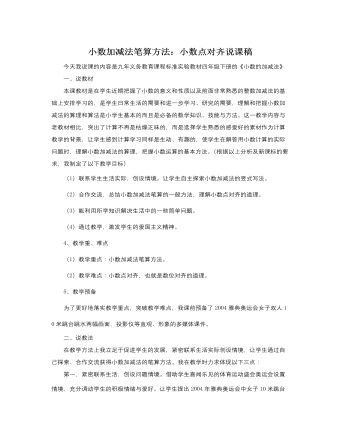
人教版新课标小学数学四年级下册小数加减法笔算方法:小数点对齐说课稿
(4)验算师:小数加减计算很轻易出错,你有什么方法检验计算的结果?(假如有困难,教师再提示一下)(三)巩固应用、内化提高 刚才的学生刚刚体会到了成功的喜悦,在此基础上,我安排了三个层次的练习。1. 基本练习,出几道直接写得数的一位小数加减法的题,让学生掌握本课的基础知识。2. 综合练习,是课后做一做1,巩固新知识,发展学生思维的机智性与灵活性。3. 提高练习,课后做一做2这是小数加减法的两步应用题,这样既培养了学生运用知识的能力,有培养了学生的创新能力。【设计意图】这样的练习的设计有密度,有坡度,形式多样,而且具有层次性。不仅巩固了学生的计算能力,而且还培养了学生的应用能力。在这个环节中,还让学生开展了自我评价、生生互评等。大大提高了学生学习的积极性。(四)回顾整理,反思提升通过今天的学习,你都有哪些收获?
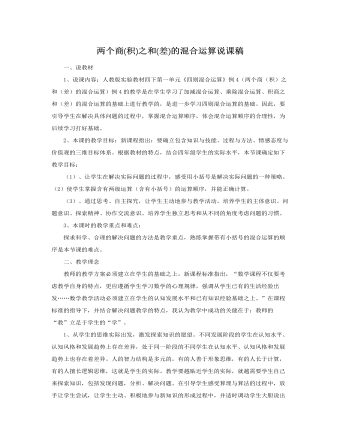
人教版新课标小学数学四年级下册两个商(积)之和(差)的混合运算说课稿
比较2和3两个算式:这两个算式的不同?请学生具体解释一下270-180为什么要用括号?让学生体会到解决问题的思路不同,解决方法也不同,计算的步数也是不同的。(再请学生分别说说这两个算式的计算过程,每一步的含义。)小结:括号是用来改变运算顺序的。当你列出的综合算式的运算顺序与实际需要的运算顺序不相符时,就用括号来改变运算顺序。比如(擦去(270-180)÷30中的括号)这样的算式中先算什么?按照混合运算顺序的规定是不能先算270-180的,要想先算这部分就要用括号把这一步括起来。这个算式才正确表示了我们解决问题的方法步骤。(设计意图:在这个环节中,在自主探索的基础上,教师给学生提供充分表达自己见解的机会,阐述自己得出的结论探究过程及疑难问题。然后根据学生反馈的信息,组织、引导学生通过个体发言、小组讨论、辩论等多种形式进行辨析评价,使学生的认知结构更加稳定和完善。)

人教版新课标小学数学四年级下册小数点位置移动引起小数大小变化说课稿
4、实际生活中的应用。提问学生:小数点位置移动引起小数大小的变化这规律在学习和生活有什么应用?(让学生思考在学习中,点错小数点的位置,小数的大小就不一样了。如果在银行统计时点错右漏写小数点会怎样?)教育学生做事认真细心。(四)小结质疑,自我评价这节课我们学习了什么?小数点位置移动引起小数大小的变化规律是怎样的?质疑:对今天的学习还有什么疑问吗?(培养学生敢于质疑,勇于创新的精神)评价:首先自评,学生对自己学得怎样,用什么方法学习,印象最深的内容是什么进行评介。接着可以生生互评或师生互评,教师重点表扬大部分学得好的同学或全班的同学,增强学生的自信心和荣誉感,使他们更加热爱数学。(五)作业布置:1、回忆一遍操作探索发现规律的整个过程,进一步培养学生良好的学习方法和习惯。2、预习97页,例2和例3,做书上98页练习第三题。
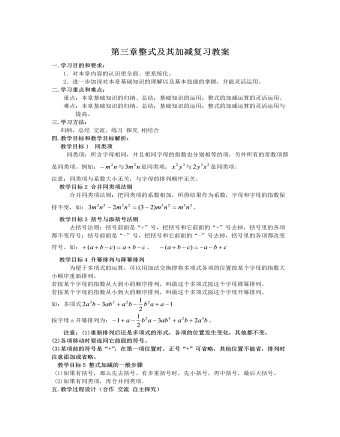
北师大初中七年级数学上册第三章复习教案
一.学习目的和要求:1.对本章内容的认识更全面、更系统化。2.进一步加深对本章基础知识的理解以及基本技能的掌握,并能灵活运用。二.学习重点和难点:重点:本章基础知识的归纳、总结;基础知识的运用;整式的加减运算的灵活运用。难点:本章基础知识的归纳、总结;基础知识的运用;整式的加减运算的灵活运用与提高。三.学习方法:归纳,总结 交流、练习 探究 相结合 四.教学目标和教学目标解析:教学目标1 同类项 同类项:所含字母相同,并且相同字母的指数也分别相等的项,另外所有的常数项都是同类项。例如: 与 是同类项; 与 是同类项。注意:同类项与系数大小无关,与字母的排列顺序无关。教学目标2 合并同类项法则 合并同类项法则:把同类项的系数相加,所得结果作为系数,字母和字母的指数保持不变,如: 。
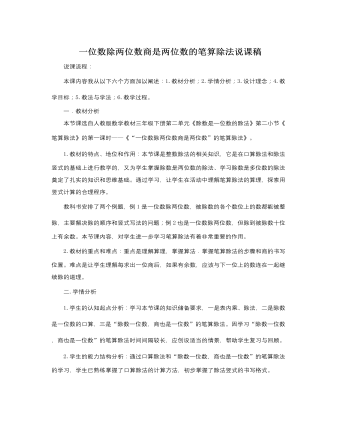
人教版新课标小学数学三年级下册一位数除两位数商是两位数的笔算除法说课稿
一.教材分析本节课选自人教版数学教材三年级下册第二单元《除数是一位数的除法》第二小节《笔算除法》的第一课时——《“一位数除两位数商是两位数”的笔算除法》。1.教材的特点、地位和作用:本节课是整数除法的相关知识,它是在口算除法和除法竖式的基础上进行教学的,又为学生掌握除数是两位数的除法、学习除数是多位数的除法奠定了扎实的知识和思维基础。通过学习,让学生在活动中理解笔算除法的算理,探索用竖式计算的合理程序。教科书安排了两个例题,例1是一位数除两位数,被除数的各个数位上的数都能被整除,主要解决除的顺序和竖式写法的问题;例2也是一位数除两位数,但除到被除数十位上有余数。本节课内容,对学生进一步学习笔算除法有着非常重要的作用。2.教材的重点和难点:重点是理解算理,掌握算法.掌握笔算除法的步骤和商的书写位置。难点是让学生理解每求出一位商后,如果有余数,应该与下一位上的数连在一起继续除的道理。
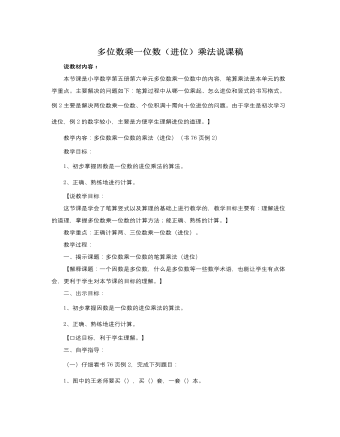
人教版新课标小学数学三年级上册多位数乘一位数(进位)乘法说课稿
说教材内容:本节课是小学数学第五册第六单元多位数乘一位数中的内容,笔算乘法是本单元的教学重点。主要解决的问题如下:笔算过程中从哪一位乘起、怎么进位和竖式的书写格式。例2主要是解决两位数乘一位数、个位积满十需向十位进位的问题。由于学生是初次学习进位,例2的数字较小,主要是方便学生理解进位的道理。】教学内容:多位数乘一位数的乘法(进位)(书76页例2)教学目标:1、初步掌握因数是一位数的进位乘法的算法。2、正确、熟练地进行计算。【说教学目标:这节课是学会了笔算竖式以及算理的基础上进行教学的,教学目标主要有:理解进位的道理,掌握多位数乘一位数的计算方法;能正确、熟练的计算。】教学重点:正确计算两、三位数乘一位数(进位)。教学过程:一、揭示课题:多位数乘一位数的笔算乘法(进位)
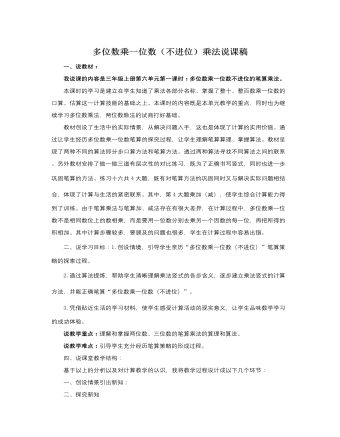
人教版新课标小学数学三年级上册多位数乘一位数(不进位)乘法说课稿
3、做练习十六第4题我用创设情境导入,接着让学生用竖式计算,并提问2是哪来的。创设情境,激发学生兴趣,使他们积极思考,主动参与,活跃课堂气氛,轻轻轻松做数学。4、判断题。让学生判断是对还是错,并说错在哪并改正。通过判断,加深学生对用竖式乘法的认识。5、做拼图题。全班合作把题完成。这道题我设计题的下面有天安门前美丽的景色。和前面文昌重建家圆相呼应。构成一个完整现实情境。通过全班合作培养学生的合作意识。四、课堂小结第四环节:总结归纳让学生说说今天学到了什么?在学生总结的同时,教师用规范的语言复述笔算乘法的计算的方法1、相同数位要对齐,2、从个位乘起,3、乘到哪一位上积就写在那一位上。使学生对所学知识有一个清晰的结构。课堂是富有生命的,说课设计毕竟不是现场上课,所以面对课堂上的生成我们还需要作出灵活的应对,我想这才是我们最大的挑战。
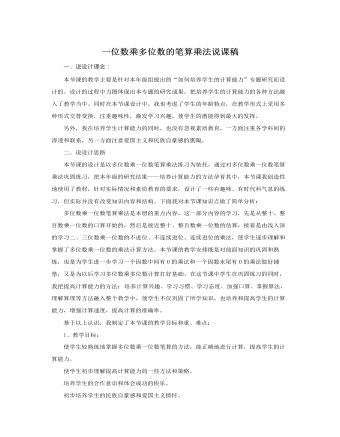
人教版新课标小学数学三年级上册一位数乘多位数的笔算乘法说课稿
三、说教法、学法从素质教育着眼点来看,要贯彻传授知识与培养能力相结合的原则,不仅要使学生学会知识,更要使学生会学、乐学、主动去学。为了更充分地发挥学生的主体地位,使他们能够自主学习,切实提高课堂教学效率。在教学方法上,采用谈话激趣、回忆交流、讨论归纳、强化练习等教学方法,循循诱导,让学生在比赛、游戏、练习、合作中自主学习,巩固和拓展所学知识。四、说教学过程“将课堂还给学生,让课堂焕发生命的活力”“努力营造学生在教学活动中自主学习的时间和空间”从这种设计理念出发,为了更好的达到教学目标,突出重点,增强教学效果,使学生计算能力得到真正发展,我对本节课设计如下几个环节:(一)、激趣导入。同学们,这几天我们一直在学习多位数乘一位数的知识,你们想不想知道我们今天要学习什么知识?
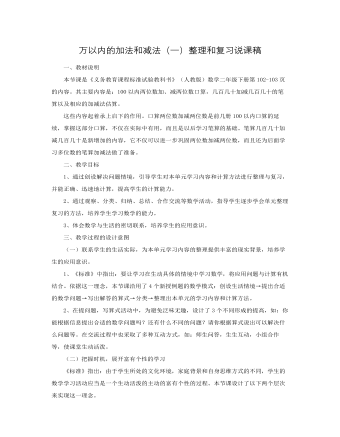
人教版新课标小学数学二年级下册万以内的加法和减法(一)整理和复习说课稿
三、估算度的把握。《标准》在计算教学方面强调的内容之一是重视估算,培养估算意识。我们认为重视估算,就是对学生数感的培养,具体体现在能估计运算的结果,并对结果的合理性作出解释。本节课的设计就是让学生在具体情境中,学会两种估算方法,结合具体情况作出合理解释。四、教会学生单元整理与复习的方法,使学生终身受益。我们知道授人以渔而非鱼的道理。在本节课中,老师设计了引导学生学会整理与复习的方法,如:带着问题看书,将算式分类、归纳、总结出本单元所学内容,计算方法,注意地方,最后进行有针对性的练习。如果我们的老师从小就有意识地对学生进行学习方法的培养,学生将终身受益。我想我们教学研讨活动就是为了实现教育的最高境界:今天的教是为了明天的不教。
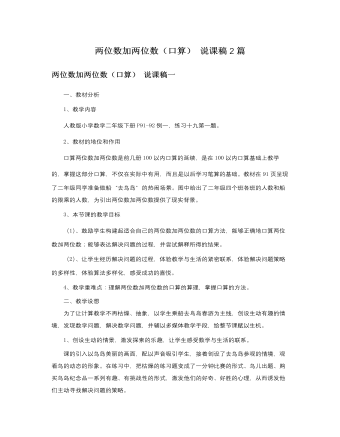
人教版新课标小学数学二年级下册两位数加两位数(口算)说课稿2篇
(四)、课堂总结、体验成功引导学生对所学知识、学习方法、学习结果、情感等进行全面总结,让学生体验学习的成功感,同时,进一步系统、完善知识结构。总之,本课的教学设计力求体现“以学生为本”的教学理念,具体体现在以下几个方面:(一)、创设生动的情景,激发探索的乐趣,让学生感受数学与生活的联系。课的引入以一幅学生经常接触的,喜闻乐见的购买玩具这一题材为切入点。在练习设计中,改变枯燥抽象的数字计算练习,选取了一组寓有童趣的素材。它们以丰富多彩的呈现方式深深地吸引着学生,使他们认识到现实生活中蕴含着大量的数学信息,使学生感到有趣、有挑战性,激发他们好奇,好胜的心理,从而诱发他们去主动寻求解决问题的策略,同时体验到数学与生活的联系。
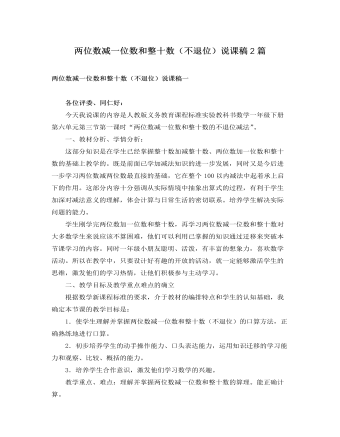
人教版新课标小学数学一年级下册两位数减一位数和整十数(不退位)说课稿2篇
3、教学目标及教学重点难点根据课标的要求,介于教材的特点和学生实际,我确定本节课的教学目标是:(1)、知识与技能:让学生经历探索两位数减一位数和整十数(不退位)的计算方法的过程,掌握计算方法,能正确地口算。(2)、过程与方法:让学生经历自主探索、动手操作、合作交流等方式获得新知的过程,积累数学活动的经验,体会数学知识与日常生活的密切联系,增强应用意识。 (3)、情感态度与价值观:进一步培养学生学习数学的热情,以及积极思考、动手实践并与同学合作学习的态度。其中,掌握两位数减一位数和整十数(不退位)的口算方法是重点,理解算理,把握两位数减一位数与两位数减整十数在计算过程中的相同点与不同点是难点。